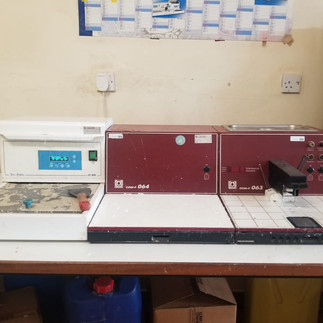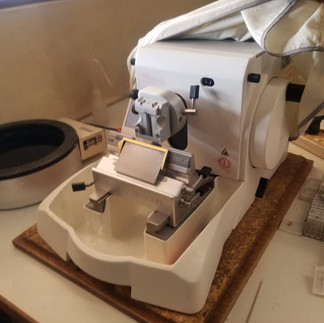January 12 - By the Jacaranda Tree - Gulu
- Teja Sathi

- Jan 12, 2023
- 3 min read
Today we started our day by visiting the principal medical office for the city of Gulu where we received a stamp (a real one) of approval to speak with the stakeholders we planned to in our letter of intent. Then, we went to Gulu Regional Referral Hospital - one of the three hospitals in the city and the only public hospital. We met with the director of the hospital who suggested a few people for us to meet and speak with: the head of OB/GYN at the hospital, the head surgeon, and the hospital's laboratory manager. We got a chance to speak with the first two people and while in the surgical ward, we were able to understand an admitted patient's journey to seeking care for what her clinician suspects to be breast cancer. We then understood the burden of breast cancer on the Regional Referral Hospital by speaking with the biostatistician in charge of hospital records. From the numbers we saw, we noted a very high ratio of screening to positive breast cancer findings and we are unsure as to why exactly that would be.

We then went to Lacor Hospital (St. Mary's Hospital Lacor) - the second of the three hospitals in Gulu - a private, non-profit hospital. Here, we met Prof. Michael Odida, a pathologist on part-time assignment at the hospital. Prof. Odida. He shared his insights about pathology's role and how it may or may not be adapted to increase reach to peripheral health centers while decreasing the turn-around-time of diagnosis. He walked us through the histopathology lab at Lacor Hospital and we were able to get a solid understanding of the process of creating a interpretable slide from a tissue sample: starting from soaking the sample in a formalin jar to passing the sample through a tissue processor, to using the microtome - the key piece of equipment in the slide preparation process. He shared technical insights about the pathology process and specifications for a potential innovation in this space. We validated some of our need angles with him and shared some laughs. He was a great person to speak with and learn from!
We walked through Lacor Hospital to try and find a contact who turned out to have left for the day, but we got to enjoy the views and shade of a Jacaranda and some Banyan trees.
After a 5PM late lunch, we headed back to the hotel to have a Zoom call with Prof. Amos Mwaka - an experienced clinician and researcher currently a PI on work related to breast cancer early detection. He completed an oncology fellowship at Fred Hutch in Seattle and a PhD focused on early detection of cervical cancer at Cambridge University. He also notably created the African Women Awareness of CANcer (AWACAN) tool to measure awareness of breast and cervical cancer in Sub-Saharan Africa. Dr. Amos provided a very keen lens on the issues we have been working to better understand and validated/shared his thoughts on the angles we are considering for our project. He also has an astute understanding of what most (including many people we have spoken with here and back in the US) simply refer to as "awareness". We are very glad we spoke with him and will be thinking on his insights throughout the rest of the trip.
Themes and takeaways from the day (and the days before) were:
Pathway Navigation: The breast cancer pathway is unclear to both patients and health care workers. This awareness of what comes next is important. When not present (as is the case currently), patients get lost in the patient pathway and at UCI.
Biopsy interpretation is centralized and biopsy acquisition is inaccessible (for skill and resource reasons) to health care workers at health centers IV and below.
There is a scarcity/lack of dedicated breast cancer clinics (which exist for cervical cancer)
There is stigma, fear of cancer, and comfort in not knowing embedded into what many refer to as "lack of awareness". Understanding the root of this can help when designing interventions in this space.













Comments